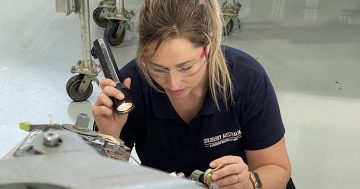Kimberly Zhang* says whether or not they’re going all the way into space, there’s a lot of science behind getting women to the top.

Photo: NASA on Unsplash
What better way to shatter a glass ceiling than by leaving the atmosphere altogether?
The first all-woman spacewalk this March was a testament to just how far we’ve come.
Down on Earth, though, we still have a long way to go.
Barriers to progress remain frustratingly solid.
Governments and employers continue to introduce initiatives to get more women to the top, yet an EY report demonstrates that progress remains slower than it should be.
What’s the holdup?
A massive study from the Peterson Institute for International Economics, which studied 21,980 firms in 91 countries, found that organisations with women in the C-suite are more profitable than those without.
Clearly, the issue isn’t one of performance.
Women deserve legitimate shots at leadership roles.
To realise those gains, however, they need more support from their employers.
A smarter way forward
Some critics have argued that women’s lack of workplace progress arises from differences in biological wiring.
That’s not the case.
New research from Tel-Aviv University indicates that male and female brains are the same, suggesting that cultural biases (not biological inclinations) are to blame.
Adults teach girls and boys, almost from the moment they’re born, to value and pursue different things (baby dolls with pink bows instead of race cars with blue stripes).
Misperceptions and siloed gender roles, not natural ineptitude, steer women away from STEM and finance fields and into more traditionally female fields, such as nursing and primary education.
That limits female participation on corporate boards in a lot of industries, according to research compiled by Catalyst.
The women who do pursue work in non-traditional fields find themselves facing an entirely new set of obstacles, all of which conspire to keep them out of the boardroom.
Cultural changes won’t come easily.
Most people continue to associate leadership with masculine traits, even though successful women don’t need to sacrifice femininity to be effective CEOs and leaders.
To combat the bias against women at work, employers must deliberately help women build ladders to the top.
Facilitate women’s leadership through action
Words alone won’t bridge the leadership divide.
To fix the issue and get more women in the leadership roles they deserve, employers should change the way they recruit, retain and empower their best overlooked employees.
In 2015, global pharmaceutical company Lilly discovered a dramatic shortage of women in company leadership roles.
Despite having a workforce that was split almost evenly between the sexes, women held only 20 per cent of top-level positions.
Only by uncovering the problem could Lilly’s management begin to correct it.
Follow Lilly’s lead, and conduct an in-depth analysis of your workplace representation to start the process.
Don’t settle for simple demographics.
Find out where the organisation fails to give women equal chances, and use that information to address the problem.
Create a deliberate strategy to bring more women to the top.
Carve a path that leads directly from frontline employee to C-suite executive.
Facilitate this growth by recruiting more women during the hiring process.
“You can’t expect diversity to happen by osmosis or chance,” says Sarah Clark, CEO of public relations firm Mitchell.
“You must establish deliberate initiatives to seek out more diverse voices.”
“That means pointing your hiring compass toward people who are currently underrepresented.”
The best way to get more women into leadership roles is to recruit great women in the first place.
However, not all employers understand the importance of equal opportunities.
Yelp discovered that targeted recruiting addressed the gender gap far better than blind hiring tactics.
Whereas blind tactics still implicitly favoured white men over other demographic representations, targeted recruiting on university campuses led to a dramatic increase in inclusive representation.
Most notably, Yelp saw an 80 per cent increase in engineering roles held by women.
Men in power naturally gravitate toward other men to groom for leadership roles.
Consciously fight that bias by creating programs to support women in their professional development.
The Women in the Workplace 2018 report from LeanIn.org and McKinsey argues that organisations should limit their number of “onlys” — women alone in groups of men.
In these situations, women often feel isolated or pressured to act a certain way.
Hilton tackled this problem by forming communities of underrepresented people at work to gather and talk about the issues they face.
Women don’t just deserve more opportunities to advance — they’ve earned them.
Now, it’s up to employers to fight unconscious biases and provide women with the resources and pathways they need to make the most of their talents.
* Kimberly Zhang is President and Editor in Chief of Under30CEO.
This article first appeared at www.entrepreneur.com.











